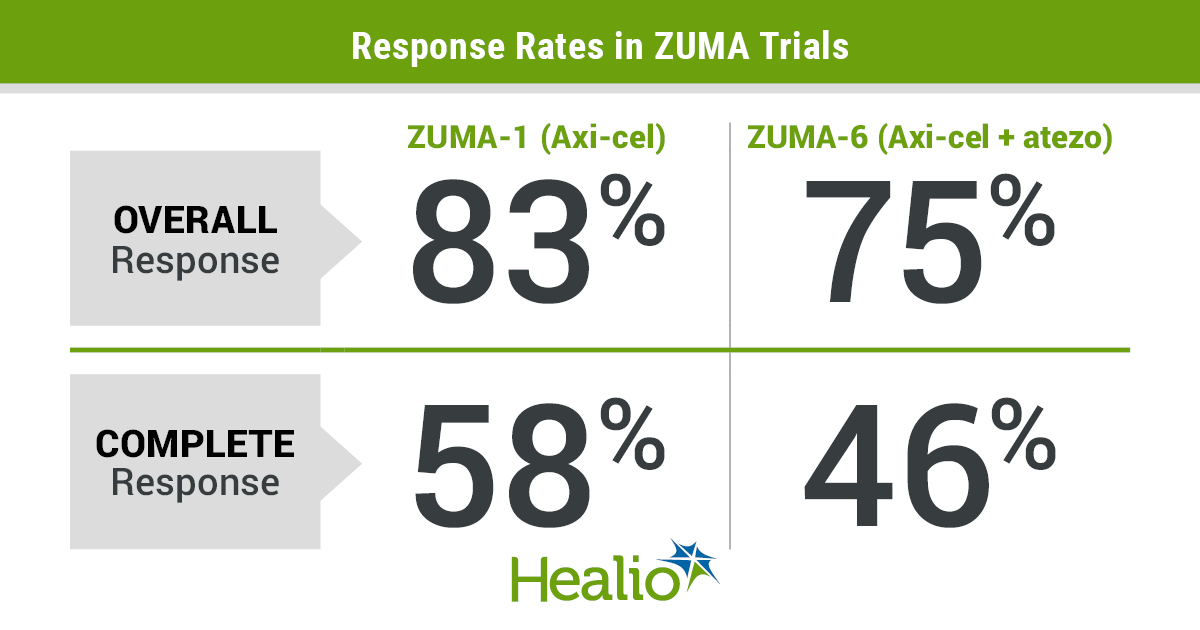CAR-T plus atezolizumab safe, effective in refractory diffuse large B-cell lymphoma
Treatment with the anti-PD-L1 antibody atezolizumab after the chimeric antigen receptor T-cell therapy axicabtagene ciloleucel appeared safe and clinically effective for refractory diffuse large B cell lymphoma, according to phase 2 results of the ZUMA-6 trial presented at the virtual American Association for Cancer Research Annual Meeting.
The combination exhibited a safety profile consistent with that reported in the pivotal ZUMA-1 trial, which evaluated axicabtagene ciloleucel (Yescarta; Kite, Gilead) — also known as axi-cel — alone among patients with DLBCL.
“Studies have shown that PD-1 is upregulated on CAR T cells and PD-L1 is upregulated on tumor cells and in most of the tumor microenvironment following CAR T-cell infusion,” Caron A. Jacobson, MD, medical director of the immune effector cell therapy program at Dana-Farber Cancer Institute, said during a presentation. “This upregulation may contribute to T-cell exhaustion and tumor cell immunization, leading to the hypothesis that checkpoint blockade may augment CAR T-cell activity.”
Adults with refractory DLBCL who received previous CD20-targeted therapy and an anthracycline-containing chemotherapy regimen were eligible for the ZUMA-6 trial. Other inclusion criteria were ECOG performance status of 0 or 1, as well as adequate bone marrow and organ function.

Patients underwent lymphodepletion chemotherapy with fludarabine dosed at 30 mg/m2 per day plus cyclophosphamide dosed at 500 mg/m2 per day for 3 days, followed by an infusion of axi-cel at 2 × 106 CAR T cells/kg.
The optimal phase 2 dosing schedule for atezolizumab (Tecentriq, Genentech/Roche), as determined by results of cohort 3 in the phase 1 study, was 1,200 mg every 21 days for four doses, starting the day after CAR T-cell infusion.
Complete response rate served as the study’s primary endpoint, with adverse events, response and CAR T-cell proliferation as secondary endpoints.
Thirty-four patients received axi-cel and at least one dose of atezolizumab as of data cutoff on Feb. 21. For the current analysis, researchers pooled data of patients in cohort 3 of phase 1 and patients in phase 2 (n = 28; median age 58 years; range, 42-71).
Most patients (86%) received at least two previous lines of therapy, with four patients having primary refractory disease. Nearly half (46%) of patients had an International Prognostic Index score of 3 or 4.
Twenty-four patients received all four doses of atezolizumab. Among those who did not receive all four doses, six patients discontinued medication due to adverse events, three stopped treatment due to disease progression and one died.
Median follow-up was 10.2 months.
The analysis showed an overall response rate of 75%, with a 46% complete response rate. In addition, 46% of patients had an ongoing response to treatment.
Median duration of response, PFS and OS had not yet been reached. Kaplan-Meier estimated 6-month rates were 62% for duration of response, 50% for PFS and 71% for OS.
Median peak CAR T-cell levels were similar between the ZUMA-6 and ZUMA-1 trials (37 cells/µL; range, 0.07-196 vs. 32 cells/µL; range, 1-1,513). Researchers also observed similar CAR T-cell expansion — as measured by area under the curve in the first 28 days —when comparing results from both trials (ZUMA-6: 497 cells/µL × days, range, 0.002-2222; ZUMA-1: 357 cells/µL × days, range, 5-11,507).
Safety results showed all patients experienced at least one adverse event, with 86% experiencing a grade 3 or greater adverse event.
Sixty-eight percent of patients experienced some form of neurotoxicity, and 29% (n = 8) had grade 3 or greater neurotoxicity.
The most common neurologic adverse events were encephalopathy in 10 patients (36%) and aphasia in four patients (14%). Median time to onset of neurotoxicity was 6 days, with a median duration of 9 days.
Ninety-six percent of patients experienced cytokine release syndrome (CRS) of any grade, with 4% of patients having grade 3 CRS. No patients experienced greater than grade 3 CRS.
Median time to onset of CRS was 2 days, with a median duration of 7 days.
There was one death during the study — a grade 5 event involving multiple organ dysfunction syndrome that the investigators determined to be unrelated to either axi-cel or atezolizumab.
“Although ZUMA-6 was not statistically powered to detect differences in outcomes compared with ZUMA-1, efficacy outcomes appear to be comparable to those with axi-cel alone,” Jacobson said.
Ongoing studies are examining the antitumor immune response of axi-cel to help identify which patients may benefit most from combination therapy with immune checkpoint inhibitors, she added.
“Further studies of axi-cel in combination with atezolizumab may be needed to establish an interaction between timing of checkpoint blockade and CAR T-cell treatment,” Jacobson concluded. – by Drew Amorosi
Reference:
Jacobson CA, et al. Abstract CT055. Presented at: AACR Annual Meeting; April 27-28, 2020 (virtual meeting).
Disclosures: This study was supported by Kite/Gilead. Jacobson reports honoraria from Celgene, Kite/Gilead, Humanigen, Nkarta, Novartis, Precision Biosciences and Pfizer; consultant/advisory roles with Celgene, Kite/Gilead, Humanigen, Nkarta, Novartis, Precision Biosciences and Pfizer; speakers bureau roles with Axis and Clinical Care Options; research funding from Pfizer; and travel support from Celgene, Humanigen, Kite/Gilead, Novartis, Pfizer and Precision Biosciences. Please see the abstract for all other researchers’ relevant financial disclosures.









